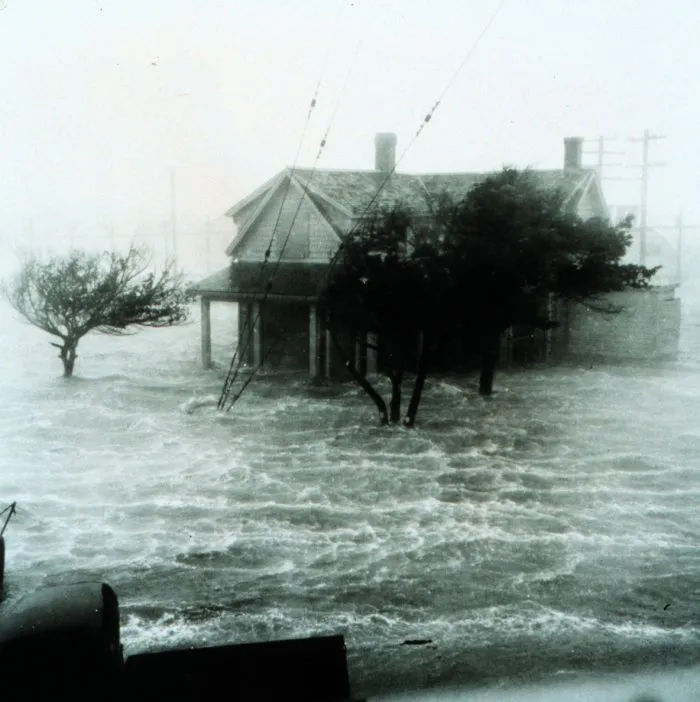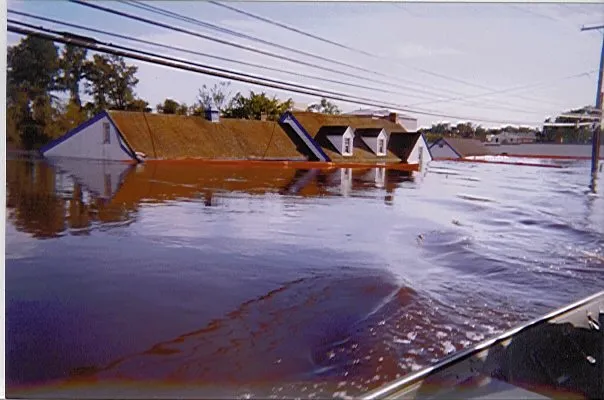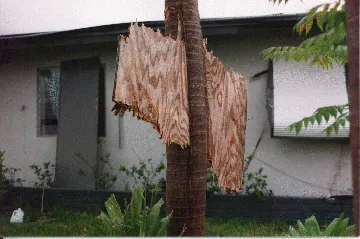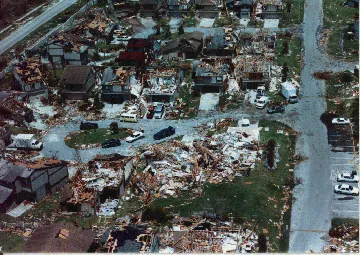Hurricane Damage

Houses in Orange Beach, Alabama, a barrier island community before (top) and after (bottom) Hurricane Ivan, which hit the coast in September 2004.
USGS
When a hurricane approaches land, tremendous damage can occur to coastal cities and towns. Hurricanes impact the natural environments along a coast, too. Huge amounts of beach sand are moved from place to place. Even large boulders can be carried in the powerful surge of ocean water. High winds can topple trees and low-lying areas are often flooded. The amount of damage depends on the strength of a storm and what it hits.
Storm Surge Along the Coast
As a storm moves towards a coast, it can cause the sea level to rise as much as 20 to 30 feet (6 to 9 meters). Wind from the storm pushes ocean water towards the land. The low pressure of the storm also allows the water level to creep higher. The water piles up with nowhere to go but onto land when it gets to the coast. The rising water, called storm surge, can submerge low-lying areas and towns along the coast. Combined with the crashing waves of the storm, storm surge can demolish docks, houses, and roads, and erode beaches. The floods from storm surge usually lasts for a short time — often just a few hours — but can cause a tremendous amount of damage. When storm surge happens at high tide, there is even more flooding.
As a hurricane approaches a coastline, scientists use a computer model called SLOSH (Sea, Lake, and Overland Surges from Hurricanes) to try to predict how much storm surge will occur. The model takes into account important factors that affect storm surge include the speed of winds in the storm, the distance that those winds travel over the ocean, how the hurricane approaches the coast (whether it is a direct impact or hits at an angle), and the shape of the coast and the ocean floor.
Inland Flooding
After a hurricane hits a coastal area, it can travel inland. At this point, the storm has typically weakened, but it can still cause damage. Torrential rains from the storm can cause rivers to flood their banks and mudslides to form.
Around the world, about 10,000 people die each year in hurricanes and tropical storms. While hurricanes produce intense winds, big waves, and even tornadoes, floodwaters are their most dangerous aspect. If a hurricane is approaching the area where you live, check for hurricane warnings. Evacuate to a safe location if it is recommended. If you live in an area prone to hurricanes, consider making a hurricane safety kit. The Hurricane Preparedness web site at the US National Hurricane Center offers tips on how to prepare for a hurricane.
Risk to Ships at Sea
When a hurricane is over the ocean and far from land, it is still a hazard to boats at sea. Before modern weather forecasting, hurricanes were the cause of many shipwrecks including several in the Bermuda Triangle, an area known for disappearing ships. Now with modern forecasting and warning systems, boats can steer clear of hurricanes. Unlike boats, oil and gas platforms over the water are unable to move out of harms way and can be damaged by the fierce wind and waves.
Coastal Hazards
When a hurricane strikes a coastal area, it brings a number of serious hazards. These hazards include heavy rains, high winds, a storm surge, and even tornadoes.

Historic NWS Collection
Storm surge pushes seawater on shore during a hurricane, flooding towns near the coast.

NWS NOAA
Heavy rains cause flooding in inland places as well. This picture was taken after Hurricane Floyd drenched parts of the U.S. East Coast with 8 to 16 inches (20 to 40 cm) of rain in 1999.

NHC NOAA
Do you see the piece of wood that is stuck in the trunk of this palm tree? Powerful winds during Hurricane Andrew drove it in there.

NHC NOAA
High winds, storm surge, flooding and tornadoes cause damage to houses and cars that are in the path of a hurricane.
While there is no way to stop a hurricane from hitting a coastal area, people in communities near the coast usually have a few days of warning as a hurricane approaches. That's enough time to get out of harm's way before the storm arrives.